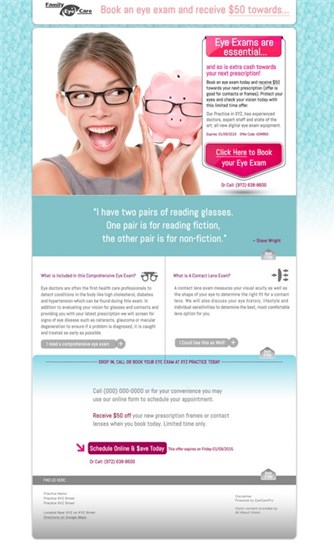By Nancy Rausman
Managing Editor, EyeCarePro
Sept. 30, 2015
SYNOPSIS
Pay-per-click advertising, via Google Adwords, lets you powerfully—and economically–market your services online to a targeted and interested audience.
ACTION POINTS
CREATE A GOOGLE ADWORDS ACCOUNT. Visit Google Adwords and follow step-by-step instructions. It’s free to open an account. You set a budget and you’re only charged according to how many clicks your ad gets.
CREATE ADWORDS LANDING PAGE. When a user clicks on your ad in the search results, it will bring them to a landing page that is linked to your web site.
TRACK YOUR RESULTS. Track your results. You can clearly measure your ROI to determine if PPC is worth the investment for your practice.
Google pay-per-click (PPC) advertising via Google Adwords, can be one of the most effective forms of local marketing for your practice. PPC enables you to create a highly targeted ad for minimal cost. It’s free to open an account, and you’re only charged according to how many clicks your ad gets.

An example of a PPC landing page EyeCarePro created for clients running an ad on eye exams. Rausman says it is important to use keywords on your landing page and practice homepage, like “eyedoctor, your city,” to make it more likely your ad will appear high in the search results when prospective patients conduct a Google search for their new eye doctor.
The basics of setting up a campaign include selecting and “bidding” on keywords, writing ads triggered by those keywords, specifying your target audience, creating landing pages and selecting a budget. “Keywords” are simply the words people most commonly use when searching online. For example, in the case of an eye doctor from St. Louis, keywords might be “eye doctor in St. Louis.” A “landing page” (pictured on the left) is the online page those who click on your ad will be led to. That page, then, can link to your practice homepage, or anywhere you would like it to link.
All this may seem like a lot of work, but when used effectively, PPC can really be worth the effort since Google Adwords makes it more likely more patients searching for an eye doctor in your geographic area will find you when they do a Google search.
There is no cost for registering, and you can even use Google Adwords simply for keyword research–to figure out the words people in your area most often use when searching for an eye doctor–without ever doing PPC. The greatest financial advantage of PPC is that you are only charged once the ad is clicked on.
You set a daily budget for your ad, including a spending limit you don’t want to exceed, but your ad showing up depends on other ads that are vying for the same keywords. So, there is a chance that if you set your budget for the ad too low, you won’t pay anything because Google won’t be showing the ad. Then you need to decide if you want to increase your limit or use different keywords.
What is PPC & Google Adwords & How Do I Use It?
PPC is based around Adwords, a keyword bidding system that works similar to an auction. The business selects the keywords they want to bid on (such as “eye doctor,” “eye exam” or “dry eyes treatment”), decides how much they want to spend and chooses combinations of those keywords in an ad that would appear on the search results page. When a user searches for those terms, Google searches the Adwords advertisers pool, and if there is more than one advertiser bidding on those terms, the auction begins to see which ad will appear first on the screen.
The tricky part is that the ad doesn’t necessarily go to the highest bidder. Google factors in two key elements to determine where your ad ranks: your highest bid and your quality score.
Quality score is based on an algorithm that determines how relevant and useful your ad is to the user, along with the relevance and quality of the associated landing page. The key to a high quality score is to launch your PPC with a well-planned, relevant and organized campaign.
Getting Started with Google Adwords
To get started on Google Adwords, go to: http://www.google.com/adwords/
Click the blue box that says “Start now”
You’ll then be presented with an easy step-by-step form in which you’ll enter the e-mail address you’d like associated with your account, as well as your practice web site, or whatever other web site you would like people to be directed to.
Next, you will setup your first campaign, Google will give you suggestions on keywords (words likely to be used by prospective patients searching online for an eye doctor in your area) based on the web site address you entered.
After that, enter your billing information, review the keywords and ads, and you’re ready to go.
Create a Google Adwords Landing Page
When a user clicks on your ad in the search results, it will bring them to a landing page that is linked to your web site. A quality landing page needs to have eye-catching graphics, a strong call to action and relevant, well-written content that includes keywords.
In the first blue box pictured on this page is an example of a PPC landing page we created for clients running an ad on eye exams.
The top of the landing page describes the promotion in bright red, accompanied by a vibrant image, keyword rich content (eye exam is included four times) and an attention-grabbing call-to-action button that links directly to the appointment link on the practice web site. As the page progresses there is additional relevant information about the practice services and eye exams, along with opportunities for the user to take action by clicking links to the appointment page.
Finally, the practice contact information, and another bold call to action button, are included at the bottom.
The goal of the landing page is to convert visitors into patients, so the page is focused on helping them to get to the appointment scheduler. Effective and visible calls to action are the key to success.
Why Should I Bother With All This?
Here are five huge benefits to using Google pay-per-click advertising:
Set your own budget. PPC is based on a pre-set budget, so once the spending amount that you selected is reached, the ad simply stops being shown. Therefore, PPC is low risk and has a controllable spending outcome.
Target using the most relevant keywords. With keyword-based campaigns, your ad will attract visitors who are genuinely interested in the product or service you are trying to promote (e.g. optometrist, eye exam, eye doctor, vision therapy, etc.).
Target specific geographic locations and demographics. You choose the geographic and demographic populations you want to target with the ad (such as a radius around your office, or city, zip code, age, gender and parental status). Your ad will only appear to those you want to attract, so you won’t be wasting your time and money advertising to individuals out of your service area.
Another source of visibility to complement organic (non-paid) search results. Especially in areas with a lot of competition vying for the coveted top search results, PPC can give your practice a chance to show up as an ad on the first page, whether or not your web site already appears in the top results.
Clear ROI. Since you can track your results, you can clearly measure your ROI to determine if PPC is worth the investment for you.
PPC can be complicated and time consuming, so many business owners hire PPC experts–such as EyeCarePro–to run the campaigns for them. Before you make the decision of whether you want to hire a professional, or take a stab at PPC yourself, stay tuned for my next article, which will provide the steps to getting new patients from PPC.
Nancy Rausman is the managing editor at EyeCarePro. Nancy is responsible for providing ECPs with educational content that helps them advance their practices through technology, management strategies and digital marketing. EyeCarePro is one of the leading providers of online marketing and practice improvement services in the industry. EyeCarePro serves both industry and practices and is the only company of its kind solely focused on the optometric space. To contact: nancy@eyecarepro.net



























